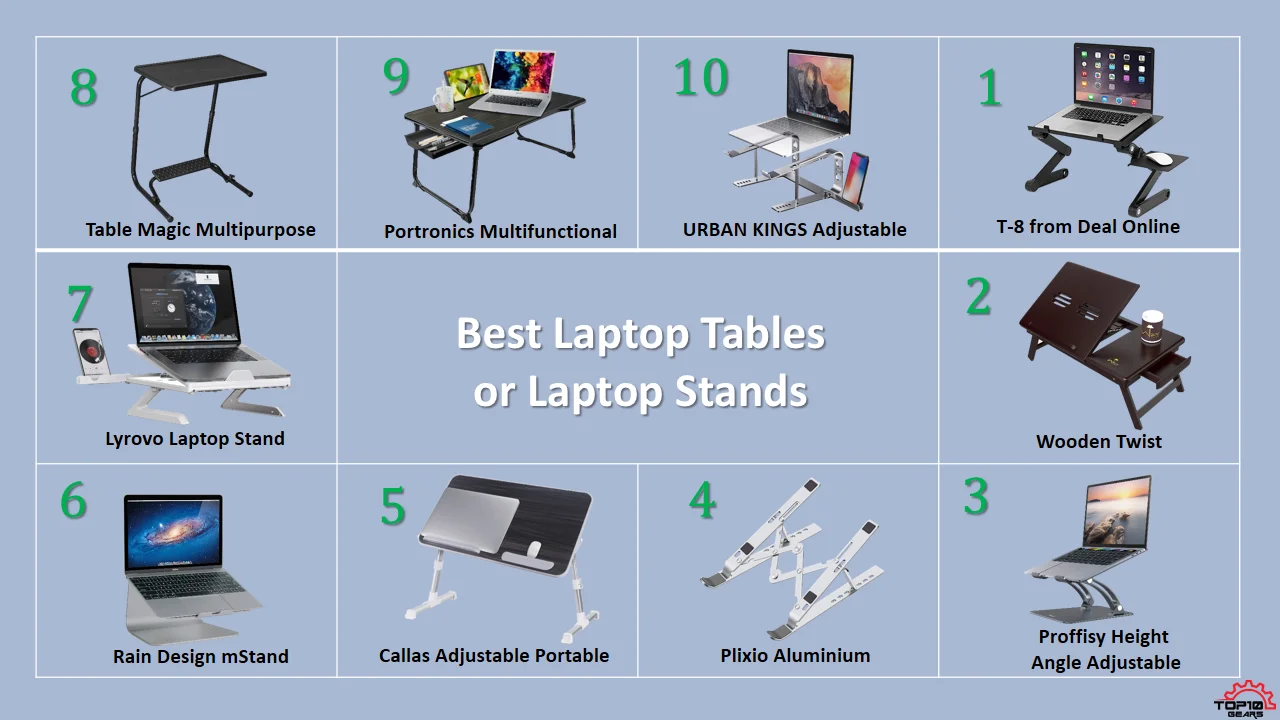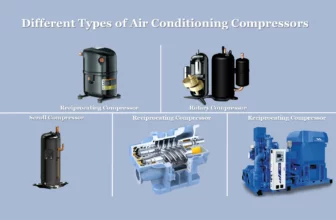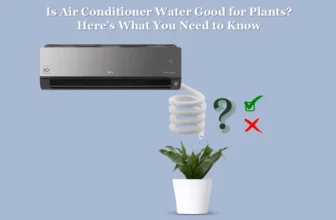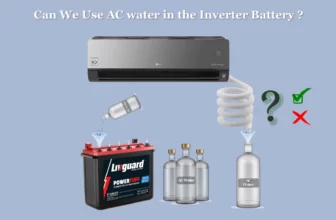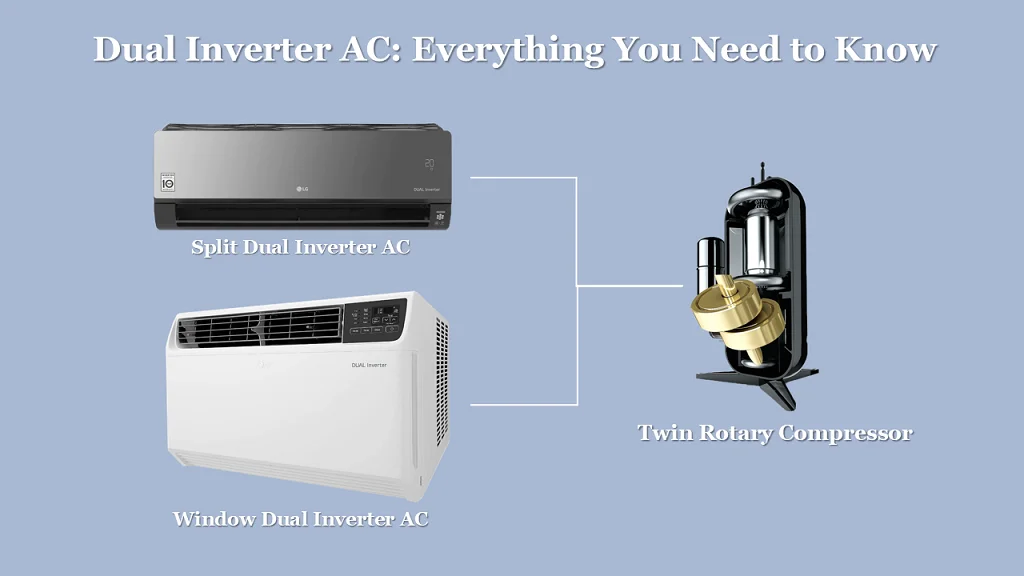
Electronic gadgets have successfully made human life comfortable in multifarious ways. We use a variety of gadgets to improve the quality of life in one or the other senses. As the average global temperature of Earth is increasing, the summers in the tropics are getting hotter. In such a scenario, demand for quality air conditioners is on the rise.
The Dual Inverter Air Conditioner, also known as Twin rotary compressor AC, is an advanced form of inverter air conditioning with two rotary compressors and two compression chambers. It provides faster cooling, reduced noise levels, high energy savings, and shorter wait time with greater stability.
Before we dive deep into the dual inverter AC, let us first look into some facts about air conditioners. The world’s first AC dates back to 1902. It was invented by Willis Haviland Carrier an engineer from Brooklyn, New York. It was a simple barebone structure.
In this air conditioning apparatus, hot air was made to pass through coils filled with cool water. Consequently, the humidity was removed, and the air was rendered cool.
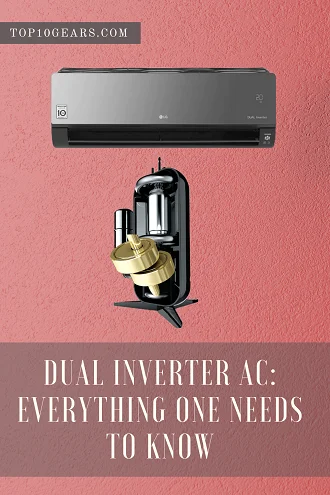
Today, the world has come a far way. Even though the foundational mechanism of present-day ACs remains the same. Yet, many advancements have come into effect. Electronic gadget technology took a great leap from regular to inverter AC to dual and even triple inverter AC.
If you are making your mind to bring an AC home, you must know about the latest technology in the market to decide better.
Presently, the most sustainable, affordable, and durable AC among all is dual inverter AC.
One by one, we bring all kinds of ACs into the spotlight, along with their properties and comparison. Here we go…
- What is a Normal and Inverter AC?
- Normal vs. Inverter AC – The Difference
- What is Dual Inverter AC Technology?
- How Dual Inverter AC Work?
- What is Smart Dual Inverter AC?
- Why Choose a Dual Inverter AC?
- Dual Inverter AC vs Inverter AC
- Dual Inverter AC vs. Triple Inverter AC
- Does Dual Inverter AC Really Save Electricity?
- How Much Electricity Does a Dual Inverter AC Consume?
- Do We Need a Voltage Stabilizer For our Dual Inverter AC?
- What are the Disadvantages of Dual Inverter AC?
- Which Brands offer Dual Inverter AC?
- Samsung Triple Inverter AC vs LG Dual Inverter AC – What’s the Difference?
- LG Dual Inverter AC Review
- Our Recommendations
- Frequently Asked Questions
- Verdict
What is a Normal and Inverter AC?
Let’s start from the basics. Before we understand differences among various AC categories, let’s first know about its core elements.
Refrigerant
Refrigerant is an entity found in several electric appliances that absorb heat. It is widely used in refrigerators as well. Refrigerant runs inside the different parts of an AC and acts as a coolant.

Refrigerant is the medium or the actual carrier of heat and performs the exchange between the external environment and internal parts of an Air Conditioner.
Compressor
An air conditioner compressor is a mechanical device that compresses and forces gas into an air conditioning system, which makes the cool air in your home.
Air Conditioners are incorporated with electric motors, which supply energy to compressors. As the name indicates, the compressor ‘compresses’ refrigerant. Upon compression, the heat-soaked refrigerant is pressurized to decrease volume.
Air conditioner compressors are made out of metals that tend to resist heat and corrosion.
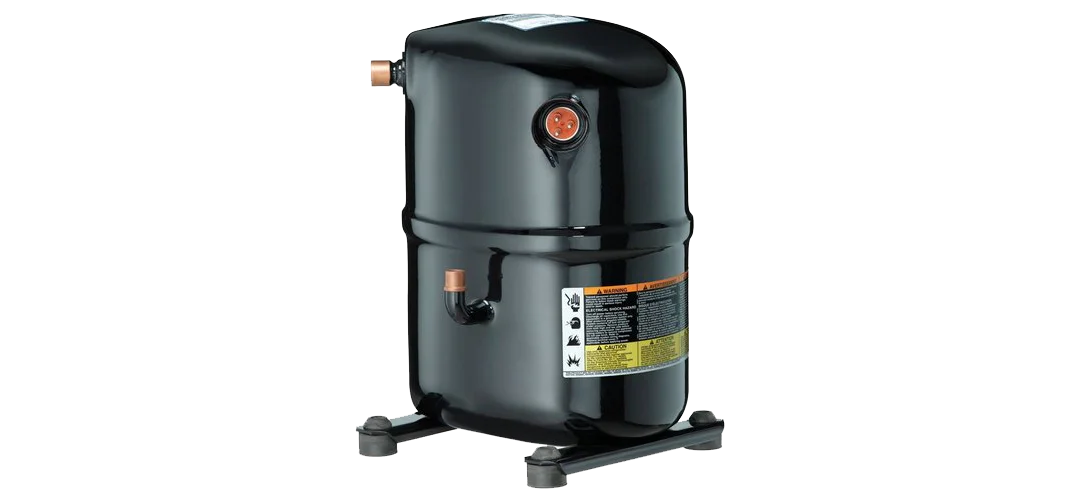
There are several types of air conditioner compressors available on the market. The scroll compressor is the most common type because it helps reduce noise. The piston compressor works well in a sealed environment with little available airflow, but it is louder than the scroll compressor.
The rotary compressor is the most efficient and helps to cool a home quickly, but it is also the noisiest of the three types of compressors.
Before purchasing an air conditioner, consider how much noise the compressor will make and whether it is necessary to have a silent machine. Most compressors produce loud noise as they run, but some are quieter than others. Decide how much of an issue this is before making a decision on which one to buy.
Read More: Different Types of Compressors in Air Conditioning Systems: Advantages & Disadvantages Explained
Condenser
The next element is a condenser. The condenser cools the superheated refrigerant as it passes over condenser coils.
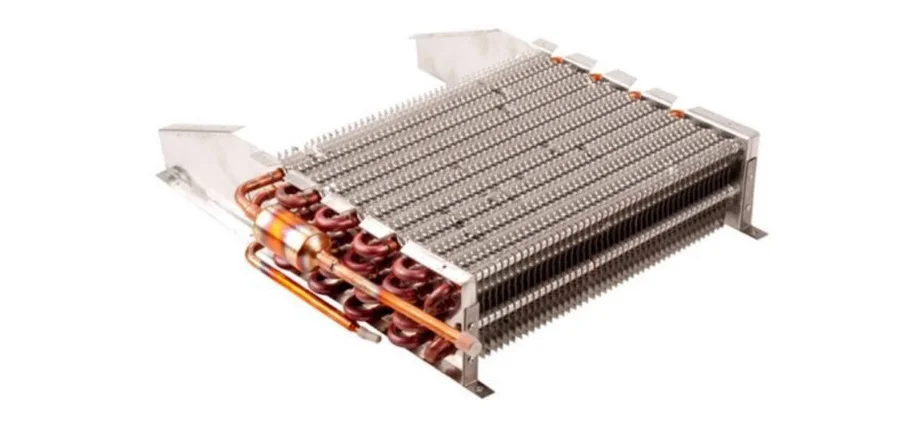
After being condensed, the refrigerant releases the heat to external surroundings, the room temperature falls, and it returns to bring more heat from indoors.
A brief Working of an Air Conditioner
By now, we know that an Air Conditioner comprises three key components-
- Evaporation apparatus
- Compressor
- Condenser apparatus
The evaporation apparatus faces indoors, towards the room or hall. It is incorporated with a liquid refrigerant. The refrigerant absorbs warm air and turns it into a gas.
Now, the compressor poses high pressure on the gaseous refrigerant to decrease its volume. These hot and high-pressure vapors of refrigerant are sent to the condenser apparatus.
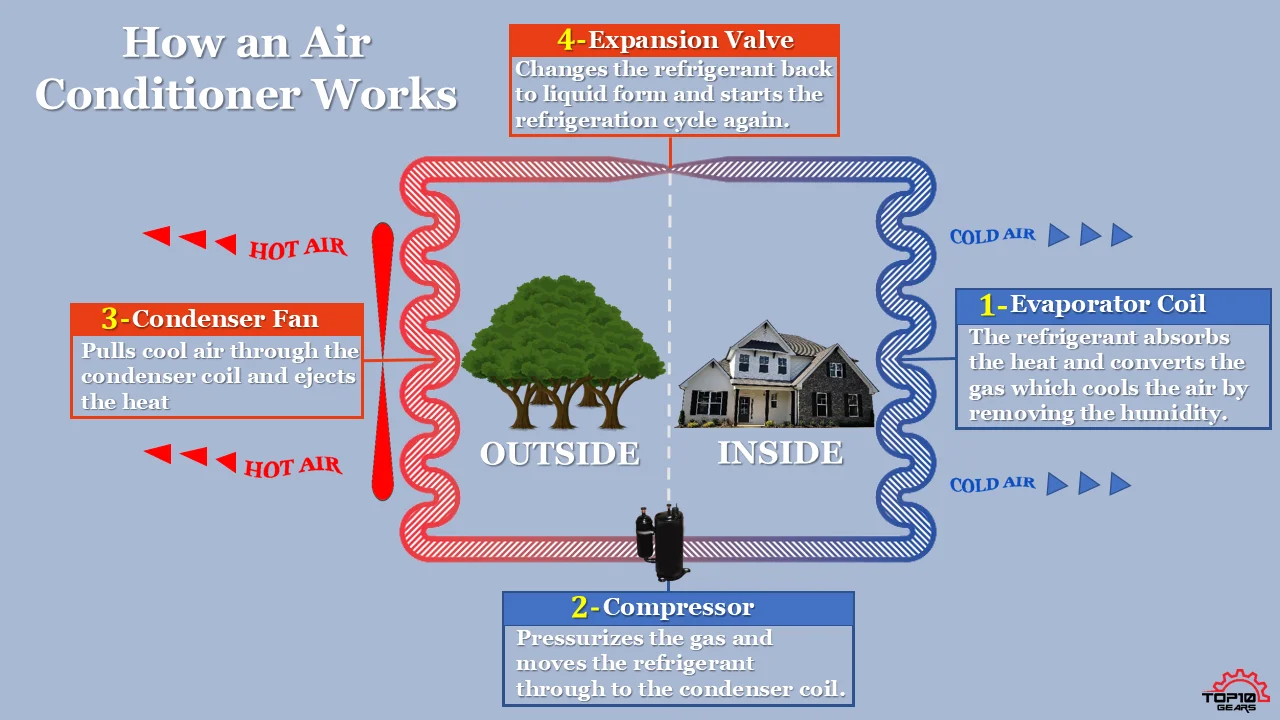
Here, cooling occurs. Condenser faces outdoors. It cools down the refrigerant and transforms it to a liquid state again. This liquefied refrigerant is sent back to the evaporation apparatus to absorb warm air again.
This cycle continues till the temperature status matches your preference. At that point, a thermostat in ACs automatically turns off the working. The cycle restarts as soon as the temperature starts rising again.
For more information on the different parts of an air conditioner and its working, refer to our comprehensive guide on the working of an air conditioner.
What is a Non-inverter or Regular AC
A non-inverter air conditioner unit has a fixed-speed compressor and a non-variable electrical supply voltage, which means that it does not have the ability to adjust the compressor speed given varying load conditions.
It is also known as a normal or regular air conditioner, and it uses an old technology of fixed-speed compressors. A regular air conditioner delivers fixed electrical supply voltage to a non-inverter AC compressor.
There is no reduced speed at partial load as would happen with the variable speed compressor in an inverter or non-inverter ac unit.
Thus, it does not have the convenience of changing the cooling capacity according to room size and it might not be as energy-efficient as an inverter ac unit, but they are more affordable and easier to use.
What is an Inverter AC
Normal non-inverter ACs sustained certain drawbacks such as noisy operation, less energy efficiency, uneven cooling, less comfortable, etc. Therefore, engineers redesigned the next generation of ACs to overcome the drawbacks residing in the previous AC version. For this, a few tweaks were made to the mode of operation.
An inverter air conditioner is a type of air conditioner that varies the compressor speed in order to maintain the desired temperature. This results in energy savings because the compressor doesn’t have to work as hard to maintain the temperature.
It is a powerful, yet energy-efficient machine that can regulate refrigerant flow and provide just the right amount of cooling or heating needed. It is known for its superior, sophisticated technology and is quite complex to understand but the crux of this technology is the variable speed compressor.
The compressors in Inverter ACs are powered by BLDC (Brush Less Direct Current) motors. These motors have the ability to keep the compressor in working mode continuously.
An inverter AC does not have frequent start/stop cycles like traditional AC units. It’s able to regulate its own operation so that it doesn’t overheat or shut down due to too high temperatures, but instead keeps running at optimal levels even if things get dicey outside!
Inverter air conditioners are also known for their ability to cool or heat a space quickly.
Normal vs. Inverter AC – The Difference

The significant difference between normal and Inverter AC lies in the mode of working.
Normal ACs have single peak power at which they work. But Inverter ACs work within a variable range of power which can be lower than the peak power value.
Unlike normal ACs, which stop working after attaining peak power, inverter ACs auto-adjust the power and keep working without switching off (until you do so).
For instance, after attaining the desired temperature of 20 degrees, the standard AC will stop working. As the temperature rises to 22 degrees, it will start again. This restarting of the AC motor requires a large amount of electricity, raising your bills.
On the other hand, inverter ACs don’t stop working after attaining 20 degrees Celsius temperature. They slow down the speed to draw minimum power, and when the temperature seems to rise, they increase their speed.
This way, the motor is always on, but much less electricity is consumed as compared to the case of restart.
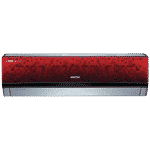
What is Dual Inverter AC Technology?
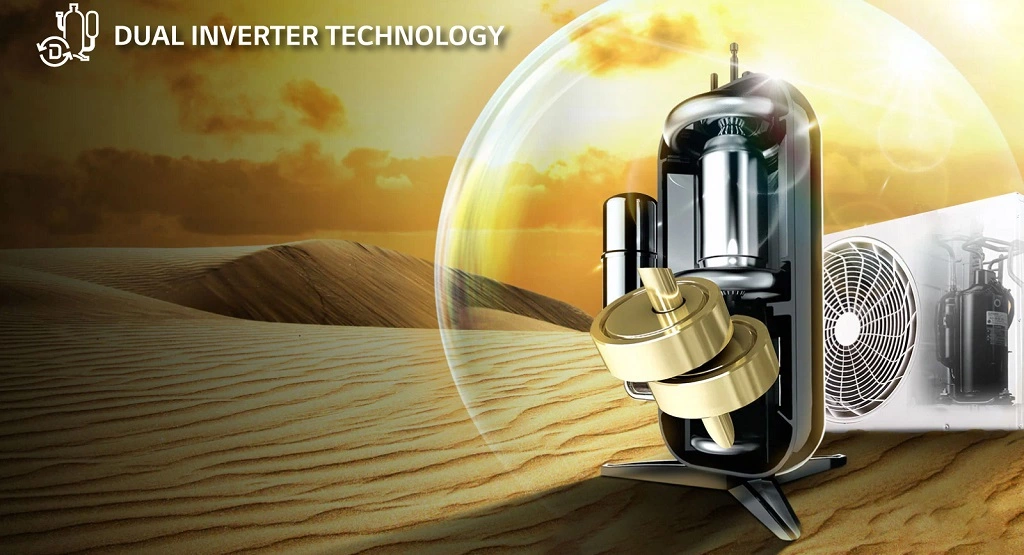
You might have come across advertisements by some big brands marketing dual Inverter ACs with claims like cost-saving, faster cooling, longer lifespan, and so on.
These claims sound too good to be true. However, dual inverter technology is indeed a game-changer and offers several benefits to consumers. This technology uses two compressors instead of one. These compressors are set to operate at a phase difference of 180 degrees.
The compressors in dual inverter ACs are powered by more advanced BLDC motors that enable these ACs to have variable power consumption and continuous working.
The presence of the BLDC motor in dual Inverter AC will offer a better working mechanism than the usual compressor by having an extensive frequency range. This compressor also manages the production of vibrations and noise while the AC is in operation.
How Dual Inverter AC Work?
The twin compressors maintain a phase difference of 180 degrees in terms of compression timing. This ensures the stable operation of the AC. This stability further becomes the reason for enhanced durability and a longer lifespan of dual Inverter ACs.
Variable tonnage trait is another admirable thing about these ACs. Tonnage is the power consumed to remove an amount of heat per hour. The more the tonnage, the more is the energy drained.
With twin compressor ACs, the power consumed is less depending upon how hot the room is. For instance, if AC is labeled with maximum tonnage as 8 tons. It will work at 5 tons if the room is small and the heat load is less.
Contrary to this, a regular would work at 8 tons always irrespective of the heat load. It lacks auto-adjustment for power consumption. So, this is where you will be saving on electricity costs.
What is Smart Dual Inverter AC?
There are different types of dual inverters available in the market. Some of them are smart, and others are not. So what’s a “smart dual inverter ac”?
It means a dual inverter AC has sensors inside, such as temperature probes or humidity monitors, so they can automatically adjust themselves based on conditions outside.
Smart dual inverter ACs can also be controlled remotely using a smartphone or other device, allowing you to turn them off when not in use without having to get up from your chair!
Why Choose a Dual Inverter AC?
Opting for dual inverter ACs is a clear win for buyers. These air conditioners have several advantages over other types of AC units. Here are some of the key benefits:
1. More Efficient
Dual inverter ACs are more efficient than traditional air conditioners. They use less energy to achieve the same level of cooling, which can save you money on your monthly energy bills. Dual inverter ACs are approximately 50% more energy efficient than other models.
2. Reduced Noise Levels
Dual inverter ACs are quieter than other types of ACs. They operate at much lower noise levels than traditional air conditioners. This is because the compressor only runs when needed, reducing wear and tear on the unit and preventing excess noise. Due to lower noise levels, you can enjoy a more peaceful environment in your home.
3. Faster Cooling
Dual inverter ACs can cool a room up to 30% faster than traditional air conditioners. This is because they have two compressors, which allows them to work more efficiently and quickly.
4. Durable
Dual Inverter ACs are more durable and have a longer life span than traditional air conditioners. They don’t need to work as hard to achieve the same level of cooling, which means that they can last for years without needing major repairs or replacements. They can withstand more wear and tear, making them a good choice for homes.
5. Quiet Cooling
Dual inverter ACs can cool a room more quickly and quietly than other types of air conditioners. They also can adjust cooling power on the fly, which means that they can maintain an optimal temperature without running all night long.
6. Improved Air Quality
Dual inverter ACs improve your indoor air quality by removing dust mites and other allergens from circulation. They also help reduce bacteria levels when used regularly, making them an excellent choice for people with allergies or asthma symptoms.
In addition, dual inverter ACs can keep your room cleaner because they won’t recycle stale air back into circulation as standard units do.
7. Amplified Comfort
Dual inverter ACs are more customizable than other types of ACs. You can adjust the speed and temperature of the fan, compressor, and evaporator to create a cooling experience that’s perfect for you.
It has features like temperature control and monitoring, auto-adjust, and high-efficiency compressors that maximize comfort for consumers.
8. Environment Friendly
Dual inverter ACs are more environmentally friendly than other types of ACs. They use less energy and produce fewer greenhouse gases, which can help the environment in the long run.
As you can see, dual inverter ACs have many advantages over other types of air conditioners. They’re more efficient, quieter, durable, customizable, environmentally friendly, and reliable (in terms of lifespan). As such, these units may be worth considering if you’re in the market for a new AC unit this year.
What could be better than this?
Dual Inverter AC vs Inverter AC

Inverters are excellent inventions made to magnify the efficacy of AC. It is one of the best ways to optimize power savings when using AC. The Inverters make the compressor capable of running at different speed levels according to the temperature range you want the AC to function.
With the use of the Inverter technology, the compressor will always be kept on. Still, the power consumption will be limited based on the level of degrees in the thermostat and also based on the degrees of the air incoming.
With the Inverter, the speed and power of the compressor are balanced and appropriately adjusted. The most noteworthy highlights of the inverter AC are that it delivers a meager operating speed, which is critical for maintaining.
The maintenance costs are usually higher. You can find the inverter mechanism in both the Spilt AC as well as Window AC. The Dual Inverter ACs are much better at work when compared to the normal Inverter ACs. The motor present in the dual Inverter ACs is very advanced and offers the best functions.
The alignment of the motors balances compressional torque, by which the appliance is significantly stabilized. The frequency range of the motors varies between 700 to 8000rpm. The 1.5-ton Dual inverter AC can perform like the 1.8-ton of normal Inverter AC.
According to the principle, the compressor motor present in the standard inverter AC can perform only a single compressing rotation. This will, in turn, give out more noise and create higher vibrations.
More stable working is rendered from the functioning of two compressors, which are operated at a phase difference of 180 degrees. 2X efficient motors are present in the dual Inverter ACs when compared to the normal ones. Better temperature control is offered by the Dual Inverter ACs, and they are the best option for energy saving.
It also has the capacity of saving energy up to 830 units. With the more stable functioning of Dual Inverter ACs, the noise generated from it is very minimal.
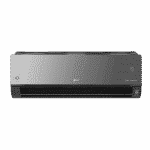
Dual Inverter AC vs. Triple Inverter AC

Integrated with three motors, as its name suggests, the Triple Inverter AC operates on a unique mechanism. It runs on the eight-pole Triple Inverter technology.
The efficacy of instant cooling is much higher on a scale of 68 percent when compared to several other air conditioners. The energy-saving options are also thrice efficient when compared to the regular variants.
A triple inverter AC was first introduced by Samsung in 2019.
The overall working performance of the system is enhanced by the introduction of the four poles present in the compressor. The temperature is maintained in accordance with the room temperature, which doesn’t require frequent on/off, so power saving is guaranteed.
It comes with a faster cooling mode technology, making the compressor run at a much greater speed for the first thirty minutes. The presence of power boost technology looks into the torque vibrations, so the noise production is null.
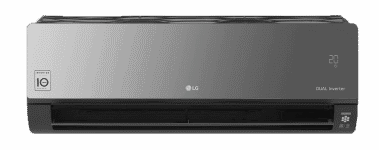

Does Dual Inverter AC Really Save Electricity?
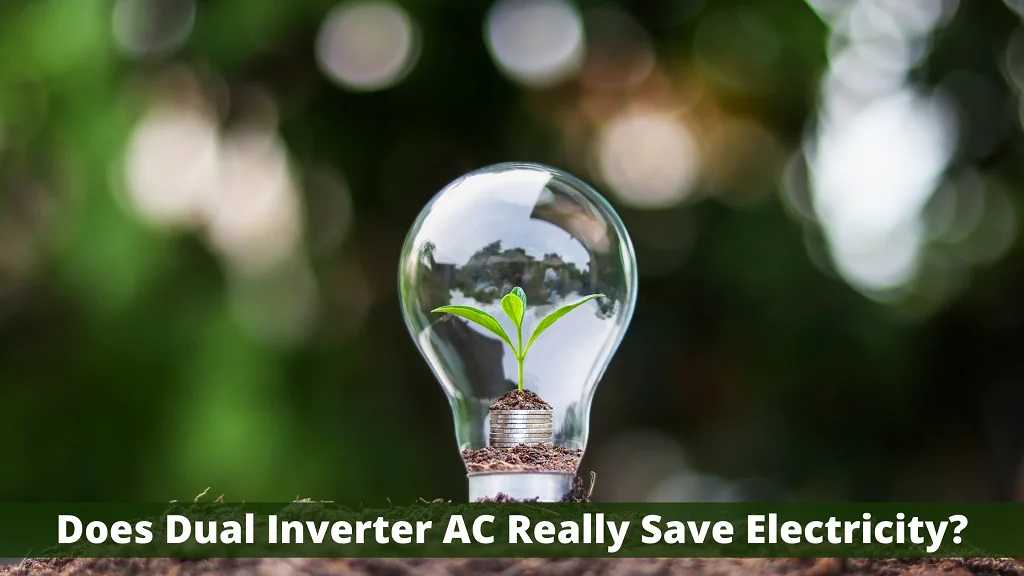
Dual inverter air conditioners are becoming more and more popular, and for good reason – they offer a number of benefits over traditional air conditioners. But one question that often comes up is whether or not they really save electricity.
The answer is yes, dual inverter ACs can save you a significant amount of money on your energy bill. How much depends on a number of factors, including the size of your home, the climate where you live, and the type of insulation in your home.
When an air conditioner is switched on, it requires a surge in power. The AC will continue to operate at full capacity until they reach the intended room temperature.
In a nutshell, the faster it happens, the more energy the AC will be able to save. Dual inverter air conditioners have a superior cooling ability than other ACs and it reaches the desired room temperature faster thus saving a lot of energy. After reaching the desired temperature, the compressor lowers its speed thus saving even more energy.
But in general, dual inverter ACs tend to be more efficient than traditional models and can save you anywhere from 10% to 30% on your energy bill.
So if you’re looking for a new air conditioner, consider a dual inverter model. They are more efficient and use less electricity than other types of air conditioners, saving you money in the long run!
How Much Electricity Does a Dual Inverter AC Consume?
The power consumption of an air conditioner is determined by its star rating, its tonnage, and the size of the room it is being used in.
Typically a 1.5 Ton 5-star Dual Inverter Split AC will consume around 835.5 watts per hour.
I personally advise you to buy an AC that is the right size for your room, rather than going for a cheaper option. You can take the help of our AC Tonnage Calculator to determine the exact tonnage required for your room.
Do We Need a Voltage Stabilizer For our Dual Inverter AC?
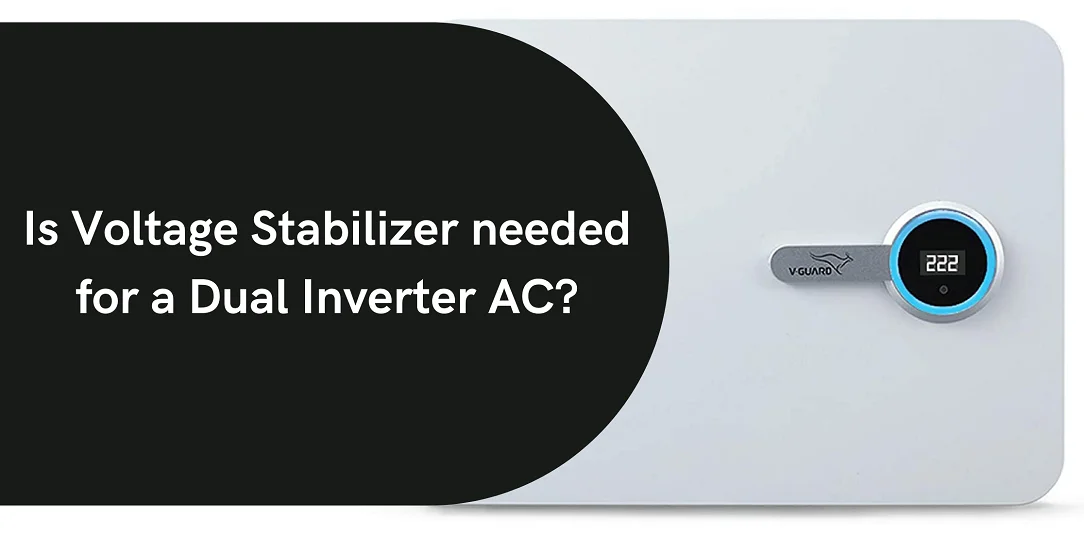
There’s a lot of debate about whether or not voltage stabilizers are necessary for dual inverter ACs. Some people say that they are, while others claim that they’re not actually necessary. The truth is that there isn’t a definitive answer – it depends on your specific situation and the type of dual inverter AC you have.
Although dual inverter air conditioners are more reliable and efficient than traditional ACs, they can still be affected by voltage fluctuations. This is why it’s a good idea to use a voltage stabilizer with your dual inverter AC, especially if you live in an area with frequent power outages or voltage fluctuations beyond the range of 145-290V.
A voltage stabilizer will help ensure that your AC runs smoothly and efficiently, even during times of instability in the electrical grid.
However, most dual inverter AC has a built-in stabilizer and might not require a stand-alone stabilizer. It is needed only if the voltage at your house fluctuates beyond the mentioned range in the manual that comes together with the dual inverter AC.
That being said, in most cases, a voltage stabilizer won’t do any harm and may offer some peace of mind, so it’s generally a good idea to have one just in case.
Read More: Does Inverter AC need Stabilizer?
What are the Disadvantages of Dual Inverter AC?

Dual inverter air conditioners are becoming increasingly popular due to their energy efficiency and performance. While dual inverter air conditioners offer several benefits, there are a few potential drawbacks you should be aware of before making a purchase.
1. Expensive
One of the biggest drawbacks of dual inverter ACs is their higher price tag than other types of air conditioners – they can be up to 50% more expensive than traditional models.
This is because they’re much more advanced in their design and require additional technology to operate. As such, you’ll likely pay a premium for a dual inverter system compared with standard models on the market today.
2. High Installation Cost
As the Dual Inverter ACs are based on advanced technology, they can be more complicated to install and require special wiring or a higher-capacity circuit breaker. This increases the installation cost.
3. High Maintenance
They require more maintenance since both the indoor and outdoor units need to be regularly cleaned to keep them running efficiently.
This new technology system requires skilled and knowledgeable technicians for repairing or solving any issue.
4. Not Suited for a Very Small Room
And finally, dual inverter ACs are not always suitable for very small rooms. So if you’re looking to cool a minimal space, you may want to consider a different type of air conditioner.
Which Brands offer Dual Inverter AC?

The best dual inverter air conditioner brands are LG, Samsung, and Daikin. These brands are known for their quality and durability, so you can be sure that you’re getting the best product possible. If you’re looking for a dual inverter AC, these are the brands to consider!
Daikin is one of the most popular brands in India, and they offer a wide range of products with different features and price points. Their dual inverter ACs are known for their high-quality build and energy efficiency rating (BEE).
LG Electronics has been making air conditioners since 1958 – so you know it’s reliable technology from an established company that knows what they’re doing when designing these appliances!
The LG Dual Inverter Air Conditioner is designed to provide cooling at lower speeds than standard single-speed units and use less energy while doing so.
Samsung is a well-known brand for electronics, especially in India. They are the only company offering dual inverter ACs with three different capacities: 0.75 tons, one ton, and two tons!
So, these are the best brands for dual inverter ACs. If you’re in the market for an energy-efficient and durable air conditioner, one of these brands is sure to have what you need!
Many other companies also manufacture dual inverter AC, but they market by different names:
| Brands | Name of Dual Inverter AC |
|---|---|
| LG | Dual Inverter |
| Sanyo | Dual Inverter |
| Toshiba | Twin Inverter |
| O’General | Twin Inverter |
| Blue Star | Dual Inverter Rotary Compressor |
Some of the companies that manufacture dual Inverter ACs are mentioned below:
- Voltas
- Mitsubishi
- Godrej
- Blue Star
- Carrier
- Hitachi
- Whirlpool
You can also check our comprehensive article on the top 15 Air Conditioning Brands in India.
Samsung Triple Inverter AC vs LG Dual Inverter AC – What’s the Difference?

The Samsung Triple Inverter AC has the prevalent eight-pole Inverter technology, which offers higher performance. This AC is intended to work astutely and effectively.
It utilizes less energy and keeps up the ideal temperature without turning off regularly. Likewise, in the dual inverter variant, the LG AC tops the list. They have a similar working process in terms of better performance and lower energy consumption.
The Samsung Triple Inverter AC also comes with the convertible model, which has a higher cooling capacity by setting the temperate in the ideal range across the room.
At the same time, the LG Dual Inverter AC comes with a setting of 4 in 1. The HD filter present in the LG Dual Inverter protects from all the bacteria and dust present in the air.
While the Antibacterial filter, Triple protection technology are some of the added advantages the Samsung Triple Inverter has. The presence of a Voltage fluctuation filter maintains the input power in the range of 130 to 290 V, so your appliance will be safe all the time. The smart installation offers a more seamless and smooth setup process.
LG Dual Inverter AC Review
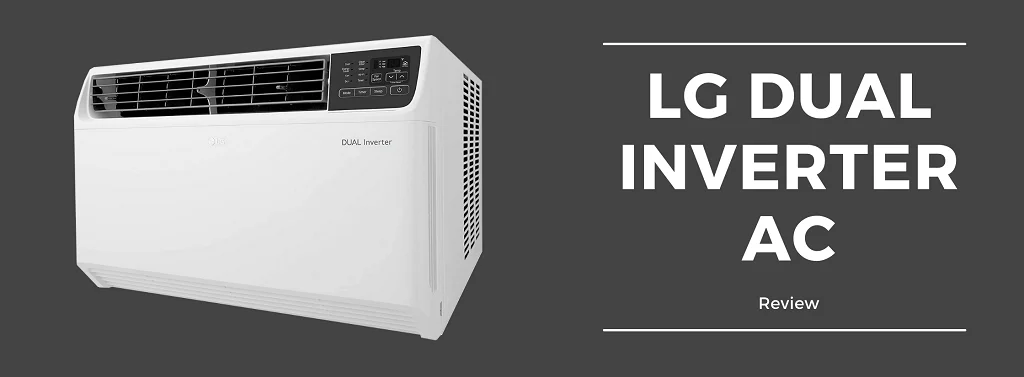
The LG Dual Inverter AC is one of the premium versions that are available in the market. It is the best, most trustable, and most reliable brand in the world. The most impressive component of the LG Dual Inverter AC is the presence of a Dual inverter compressor.
Dual Inverter Compressor motor
The Varied Speed Dual Rotary Motor present in the Dual inverter compressor of LG’s AC has a more extensive rotational recurrence, saving more energy alongside a higher cooling range than traditional air conditioners. This guarantees that the dual Inverter ACs have then tendency to cool quicker and run calmer, and the effect is long-lasting.
4 in 1 cooling
Another highlight feature is the presence of a compatible 4 in 1 cooling mechanism. This 4-in-1 flexible option in the Air Conditioner is an ideal illustration of the cooling necessities that are offered by the machine. The fluctuated models discover that ideal energy uses are guaranteed with no trade-offs on the side of comfort.
Himalayan cool
The Himalayan cool features offer you the incompressible cooling effect as soon as you switch on the AC. By just tapping the button, you get to experience the ultimate cooling effect.
Ocean Blackfin
This Ocean blackfin acts as a protective barrier against all bacteria and dust. It also serves as an anti-inflammation barrier that holds all the sensitive, allergic particles inside. It also renders the anti-fin corrosion mechanism, so max cooling and higher performance are for sure.
HD filter
This particular filter is made of a very closely wound mesh layer that can effectively capture all dirt and dust, mainly up to 10 micrometers. It also increases the durability and cleanliness of the air conditioner.
Complete copper protection
The complete copper protection ensures the top quality of the air that the AC renders into your living space. The employment of this copper also acts as an anti-corrosion resistance which safeguards your machine in the long run.
Final Thoughts on LG Dual Inverter ACs
The service of installation and delivery provided by LG is so excellent and very much appreciable. The company also provides the facility of same-day installation. The outer unit stand is also provided for a bit of cost, which is totally optional.
The customer service provided by LG was very top-class and in amicable manner. The quality of the product is so lovely; it is user-friendly and efficient.
Our Recommendations
Table could not be displayed.Frequently Asked Questions
Verdict
When we invest more money, we seek more comfort. This is particularly for electronic items. Dual inverter ACs are going to provide you with equal value for money in every sense. They are equipped with every feature you desire.
Be it optimum cooling comfort, cost-saving, high-quality operation, noise reduction, or temperature control, dual inverter ACs aren’t going to disappoint you. Comparison in terms of cost, triple inverter technology is the costliest of all, whereas ordinary ACs cost the lowest of all three.
In the middle lies, dual inverter variant with an affordable price point, desirable features, and optimum quality. Bring this AC home today and experience the heights of comforts with your family!
When choosing an air conditioning system for your home or business, it is important to purchase the right capacity. Our AC tonnage calculator can help you with that!
However, if you plan on purchasing a new Dual Inverter AC unit then check out our extensive AC buying guide about which ones will work best in different spaces.
We hope that you enjoyed reading this article and it helped you understand most of the things related to the dual inverter air conditioners. If it did, share it with your dear ones or on social media to spread the knowledge!
If there are any questions left unanswered or any mistakes in the information provided here – please don’t hesitate and let us know in the comments below. We’ll make sure to rectify those errors soon enough.
Thank You :)-

